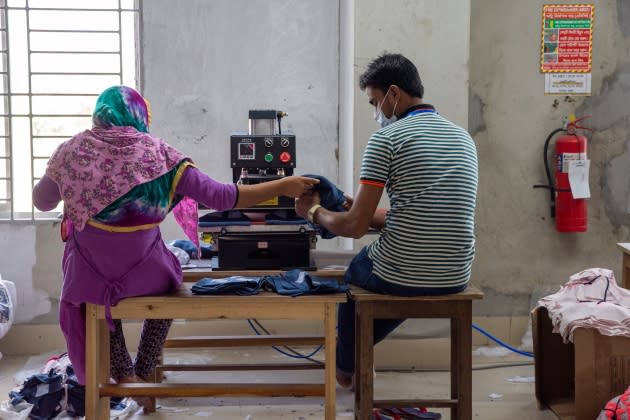Gucci Among Top, Savage x Fenty Among Bottom in Fashion Revolution Index 2023

Fashion still has a long way to go to address global inequality, if Fashion Revolution has any say-so.
Now in the eighth year of publishing its proprietary report, the Fashion Revolution Transparency Index for 2023 again catalogs worker rights, purchasing practices, wages and more as it relates to fashion’s sustainability aims. This year’s report was funded by The Laudes Foundation and the European Climate Foundation, in part. As with previous iterations, Fashion Revolution cataloged 250 fashion brands across categories, with revenues over $400 million. The brands are ranked according to 258 in-depth indicators spanning focuses like living wages and climate to new topics like degrowth, coal phase-out and a “just transition.”
More from WWD
Gucci President Marco Bizzarri Makes Personal Donation to Emilia Romagna Families
Sue Bird Goes Sheer in Gucci Lace Suit With Romantic Details for ESPYs 2023 Red Carpet
The Best Amazon Prime Day 2023 Fashion Clothing Deals to Shop Now
In brief, Fashion Revolution defines transparency as the public disclosure of business practices that enables people — consumers namely — to hold decision makers accountable. A just transition, meanwhile, is the ability to provide a viable future in a low-carbon economy for the workers that underpin the existing fashion system.
For the first time since the index was published in 2017, two fashion brands scored 80 percent or higher, including Gucci (80 percent) and OVS (83 percent). Per the report, the five “biggest movers” this year are all luxury brands — including Gucci, Armani, Jil Sander, Miu Miu and Prada — with Gucci showing the biggest increase. OVS, once again, took the top spot because of its strongest disclosure rates and detailed public information.
The laggards, this year, include a swath of 18 brands that scored a 0 percent rating, including Anta, Belle, Big Bazaar, Bosideng, Fashion Nova, K-Way, Koov, Max Mara, Metersbonwe, Mexx, New Yorker, Heilan Home, Savage x Fenty, Semir, Splash, Tom Ford, Van Heusen and Youngor. All in all, 71 out of 250 brands (or 28 percent) scored in the 0 to 10 percent range. This is a slight improvement from 31 percent last year. Brands scoring 0 to 10 percent are disclosing little to nothing at all, per the index.
Other indicators of social progress include executive compensation linked to ESG goals (which only 18 percent of brands do today) and living wages (only a mere 1 percent disclose). The report showed that only 5 percent of brands disclose information on how they are up-skilling the workforce (women, especially) to retain higher paying jobs and leadership roles in the circular economy.
“With skyrocketing inflation and living costs globally, it is more urgent than ever that the people who make our clothes can afford to live decently and be able to provide for themselves and their families,” Liv Simpliciano, policy and research manager at Fashion Revolution, told WWD. “Mandatory legislation on living wages is necessary to level the playing field so no business can continue to operate with impunity and profit from the undervalued work of garment workers — this is why we launched our Good Clothes, Fair Pay campaign [which advocates for fair pay legislation in the European Union].”
As for planetary health, only 23 percent of major brands and retailers disclose their methodology to identify toxic chemical risks and even fewer (7 percent) disclose their wastewater test results. A key proponent of sky-high overproduction rates, only 12 percent of brands disclose their annual production volumes.
Things like annual production volume and living wages should be foundational in the industry, per Fashion Revolution, and many empathetic ESG professionals agree.
“Though there may be vested interest in withholding this information, fashion’s overproduction problem is choking communities in the Global South who receive imported clothes — this problem is now visible even from space,” Simpliciano said. “Whether or not brands tell us their production volumes, one thing is clear — the global fashion industry cannot hide from the reality that it is perpetuating absurd excess at the expense of the environment and people who make our clothes.”
Fewer still offer insight on fuel disclosure (a new metric denoting coal reliance, which only 6 percent disclose). As for biodiversity, just 12 percent of brands published a “time-bound, measurable” commitment to zero deforestation this year compared to 15 percent last year. In addition, only 7 percent published measurable progress toward achieving zero deforestation.
That being said, there are some shifts witnessed in transparent reporting. More than half (52 percent) of 250 major brands reviewed are disclosing their first tier supplier lists, what Fashion Revolution called “a promising shift” compared to 32 out of 100 brands (32 percent) in the first edition of the index. And with the European Union spearheading due diligence laws, more fashion brands are disclosing how they consult affected stakeholders, among other indicators.
As for how Fashion Revolution is pushing the conversation forward, Simpliciano said the Fashion Transparency Index’s 61 percent participation rate is proof case for progress. “Our research has also proven that the longer brands engage with us, the more transparent they will be — which ultimately means they can be held more accountable.”
Best of WWD

